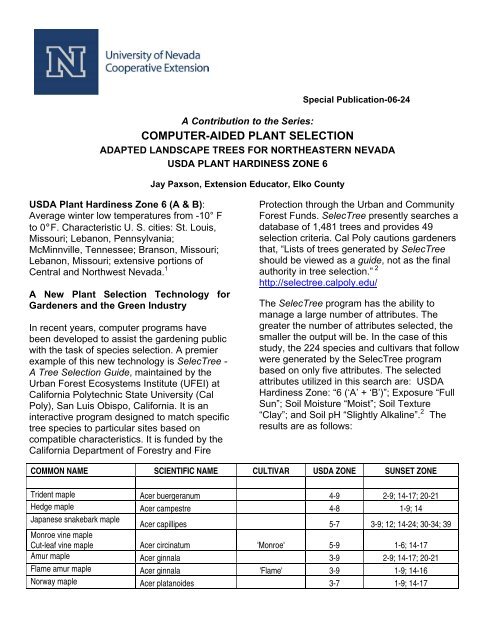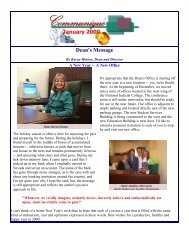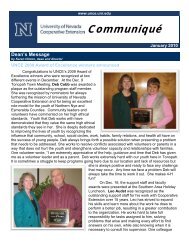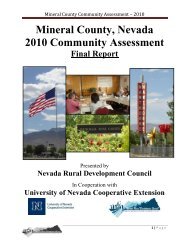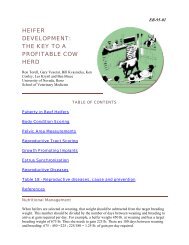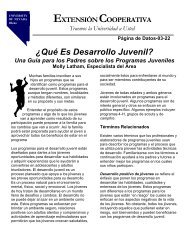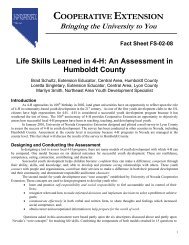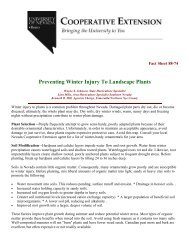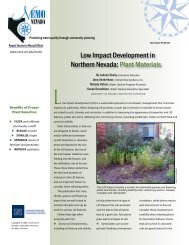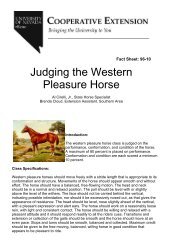Computer-Aided Plant Selection, Adapted Landscape Trees for ...
Computer-Aided Plant Selection, Adapted Landscape Trees for ...
Computer-Aided Plant Selection, Adapted Landscape Trees for ...
You also want an ePaper? Increase the reach of your titles
YUMPU automatically turns print PDFs into web optimized ePapers that Google loves.
Special Publication-06-24<br />
A Contribution to the Series:<br />
COMPUTER-AIDED PLANT SELECTION<br />
ADAPTED LANDSCAPE TREES FOR NORTHEASTERN NEVADA<br />
USDA PLANT HARDINESS ZONE 6<br />
Jay Paxson, Extension Educator, Elko County<br />
USDA <strong>Plant</strong> Hardiness Zone 6 (A & B):<br />
Average winter low temperatures from -10° F<br />
to 0°F. Characteristic U. S. cities: St. Louis,<br />
Missouri; Lebanon, Pennsylvania;<br />
McMinnville, Tennessee; Branson, Missouri;<br />
Lebanon, Missouri; extensive portions of<br />
Central and Northwest Nevada. 1<br />
A New <strong>Plant</strong> <strong>Selection</strong> Technology <strong>for</strong><br />
Gardeners and the Green Industry<br />
In recent years, computer programs have<br />
been developed to assist the gardening public<br />
with the task of species selection. A premier<br />
example of this new technology is SelecTree -<br />
A Tree <strong>Selection</strong> Guide, maintained by the<br />
Urban Forest Ecosystems Institute (UFEI) at<br />
Cali<strong>for</strong>nia Polytechnic State University (Cal<br />
Poly), San Luis Obispo, Cali<strong>for</strong>nia. It is an<br />
interactive program designed to match specific<br />
tree species to particular sites based on<br />
compatible characteristics. It is funded by the<br />
Cali<strong>for</strong>nia Department of Forestry and Fire<br />
Protection through the Urban and Community<br />
Forest Funds. SelecTree presently searches a<br />
database of 1,481 trees and provides 49<br />
selection criteria. Cal Poly cautions gardeners<br />
that, “Lists of trees generated by SelecTree<br />
should be viewed as a guide, not as the final<br />
authority in tree selection.” 2<br />
http://selectree.calpoly.edu/<br />
The SelecTree program has the ability to<br />
manage a large number of attributes. The<br />
greater the number of attributes selected, the<br />
smaller the output will be. In the case of this<br />
study, the 224 species and cultivars that follow<br />
were generated by the SelecTree program<br />
based on only five attributes. The selected<br />
attributes utilized in this search are: USDA<br />
Hardiness Zone: “6 (‘A’ + ‘B’)”; Exposure “Full<br />
Sun”; Soil Moisture “Moist”; Soil Texture<br />
“Clay”; and Soil pH “Slightly Alkaline”. 2 The<br />
results are as follows:<br />
COMMON NAME SCIENTIFIC NAME CULTIVAR USDA ZONE SUNSET ZONE<br />
Trident maple Acer buergeranum 4-9 2-9; 14-17; 20-21<br />
Hedge maple Acer campestre 4-8 1-9; 14<br />
Japanese snakebark maple<br />
Acer capillipes 5-7 3-9; 12; 14-24; 30-34; 39<br />
Monroe vine maple<br />
Cut-leaf vine maple Acer circinatum 'Monroe' 5-9 1-6; 14-17<br />
Amur maple Acer ginnala 3-9 2-9; 14-17; 20-21<br />
Flame amur maple Acer ginnala 'Flame' 3-9 1-9; 14-16<br />
Norway maple Acer platanoides 3-7 1-9; 14-17
Cleveland maple Acer platanoides 'Cleveland' 4-7 1-9; 14-17<br />
Columnare maple Acer platanoides 'Columnare' 4-7 1-9; 14-17<br />
Emerald Queen maple Acer platanoides 'Emerald' 4-7 1-9; 14-17<br />
Summer Shade maple Acer platanoides 'Summer Shade' 4-7 1-9; 14-17<br />
Red maple Acer rubrum 3-9 1-9; 14-17<br />
Autumn Flame red maple Acer rubrum 'Autumn Flame' 4-8 1-9; 14-17<br />
Columnar red maple Acer rubrum 'Columnare' 3-9 1-9; 14-17<br />
Gerling red maple Acer rubrum 'Ferling' 4-8 1-9; 14-17<br />
Red Sunset red maple Acer rubrum 'Red Sunset' 4-8 1-9; 14-17<br />
Silver maple Acer saccharinum 3-8 1-9; 12; 14-24<br />
Sugar maple Acer saccharum 3-8 1-10; 14-20<br />
Green Mountain sugar maple Acer saccharum 'Green Mountain' 3-8 1-10; 14-20<br />
Newton Sentry sugar maple Acer saccharum 'Newton Sentry' 3-8 1-10; 14-20<br />
Temple's Upright sugar maple Acer saccharum 'Temple's Upright' 3-8 1-10; 14-20<br />
Red horsechestnut Aesculus carnea 4-9 1-10; 12; 14-17<br />
Briottii red horsechestnut Aesculus carnea 'Briottii' 3-7 1-10; 12; 14-17<br />
Common horsechestnut Aesculus hippocastanum 4-7 1-10; 14; 14-17<br />
Tree-of-Heaven Ailanthus altissima 4-8 1-24<br />
Silk tree Albizia julibrissin 6-10 4-23<br />
Silk tree Albizia julibrissin 'Rosea' 6-10 4-23<br />
Italian alder Alnus cordata 5-9 8-9; 12-24<br />
Black alder Alnus glutinosa 3-7 1-10; 14-24<br />
Japanese angelica Aralia elata / A. chinensis 3-8 1-10; 14-24<br />
Devil's walking stick Aralia spinosa 4-9 2-24<br />
Pawpaw / Custard apple<br />
Asimina triloba 5-8 2-9; 14; 18-21; 28-41<br />
European white birch Betula pendula 3-6 1-12; 14-24<br />
Japanese white birch Betula platyphylla japonica 4-7 1-11; 14-24<br />
Paper mulberry Broussonetia papyrifera 6-11 3-24<br />
Incense cedar Calocedrus decurrens 5-8 1-12; 14-24<br />
Colossal chestnut<br />
Sweet chestnut Castanea 'Colossal' 4-8 1-9; 14-17<br />
Spanish chestnut Castanea sativa 4-11 1-9; 14-17<br />
Common catalpa Catalpa bignonioides 5-9 1-24<br />
Western catalpa Catalpa speciosa 4-8 1-24<br />
Cedar of Lebanon Cedrus libani 5-8 3-10; 14-24<br />
Sugar hackberry Celtis laevigata 5-9 2-20<br />
Cyprus cedar / Cyprian cedar Cedrus brevifolia 5-8 5-24; 32<br />
Common hackberry Celtis occidentalis 3-9 1-24<br />
Eastern redbud Cercis canadensis 4-9 1-24<br />
White eastern redbud Cercis canadensis 'Alba' 4-9 1-24<br />
Purple-leaf eastern redbud Cercis canadensis 'Forest Pansy' 4-9 1-24<br />
Western redbud Cercis occidentalis 4-9 1-24<br />
Judas tree Cercis silaquastrum 5-9 3-19<br />
Chinese fringe tree Chionanthus retusus 3-9 2-9; 14-24
Giant dogwood Cornus controversa 5-8 3-9; 14; 18-19<br />
Autumn Glory hawthorn Crataegus 'Autumn Glory' 4-7 A-2; A-3; 2-12; 14-17<br />
Toba hawthorn Crataegus 'toba' 'Toba' 4-7 A-3; 1-10<br />
Cockspur thorn Crataegus crus-galli 3-7 1-11; 14-17<br />
English hawthorn Crataegus laevigata 'Crimson Cloud' 4-8 1-11; 14-17<br />
Paul's Scarlet English<br />
hawthorn Crataegus laevigata 'Paul's Scarlet' 4-8 2-12; 14-17<br />
Carriere hawthorn Crataegus lavallei 4-7 3-12; 14-21<br />
Washington hawthorn Crataegus phaenopyrum /<br />
Crataegus cordata 4-8 3-12; 14-17<br />
Japanese cryptomeria Cryptomeria japonica 6-9 4-9; 14-24<br />
Plume cryptomeria Cryptomeria japonica 'Elegans' 6-9 4-9; 14-24<br />
Leyland cypress Cupressocyparis leylandii 6-10 3-24<br />
Naylor's Blue Leyland cypress Cupressocyparis leylandii 'Naylor's Blue' 6-10 3-24<br />
Atlas broom Cytisus battandieri 5-8 5-6<br />
Quince Cydonia oblonga 5-8 1-21<br />
American persimmon Diospyros virginiana 4-9 3-9; 14-16; 18-23<br />
Russian olive Elaeagnus angustifolia 3-8 1-3; 7-14; 18-19<br />
Silverberry Elaeagnus pungens 6-10 4-24<br />
Evergreen euonymus Euonymus japonicus 5-11 4-13; 18-20<br />
American beech Fagus grandifolia 3-8 1-6<br />
European beech Fagus sylvatica 4-7 2-9; 14-21<br />
White ash Fraxinus americana 3-9 1-11; 14-17<br />
'Autumn<br />
Applause' 4-9 1-11; 14-17<br />
Autumn Applause white ash Fraxinus americana<br />
European ash Fraxinus excelsior 5-8 7-24<br />
Holotricha ash Fraxinus holotricha 6-9 4-24<br />
Flowering ash Fraxinus ornus 6-9 3-9; 14-17<br />
Raywood ash Fraxinus oxycarpa 'Raywood' 5-8 7-24<br />
Marshall Seedless green ash Fraxinus pennsylvanica 'Marshall' 3-8 1-6<br />
Summitt green ash Fraxinus pennsylvanica 'Summitt' 3-8 1-6<br />
Green ash / red ash Fraxinus pennsylvanica 3-9 1-6<br />
Mt. Aetna broom Genista aethnensis 6-7 4-9; 12-22<br />
Maidenhair tree Ginkgo biloba 3-8 1-10; 12; 14-24<br />
Autumn Gold maidenhair tree Ginkgo biloba 'Autumn Gold' 3-8 1-10; 12; 14-24<br />
Fairmont maidenhair tree Ginkgo biloba 'Fairmont' 3-8 1-10; 12; 14-24<br />
Imperial honey locust Gleditsia triacanthos inermis 'Imperial' 4-8 1-16; 18-20<br />
Kentucky coffee tree Gymnocladus dioica 3-8 1-3;7-10; 12-16; 18-21<br />
Rose of Sharon Hibiscus syriacus 5-10 1-21<br />
Japanese raisin tree Hovenia dulcis 6-10 1-9; 14-24<br />
Idesia Idesia polycarpa 6-8 4-9; 14-24<br />
English walnut Juglans regia 5-9 1-9; 14-23<br />
English holly Ilex aquifolium 5-9 4-9; 12-24<br />
American holly Ilex opaca 5-9 2-9; 15-16; 20-23<br />
Perny holly Ilex pernyi 7-10 4-9; 14-24<br />
Chinese juniper Juniperus chinensis 4-9 1-24
Hollywood juniper Juniperus chinensis 'Torulosa' 4-11 1-24<br />
Rocky Mountain juniper Juniperus scopulorum several varieties 4-9 1-24<br />
Eastern red cedar Juniperus virginiana 2-9 1-24<br />
Goldenrain tree Koelreuteria paniculata 5-9 2-21<br />
Kew goldenrain tree Koelreuteria paniculata 'Kew' 5-9 2-21<br />
European larch Larix decidua 3-6 1-9; 14-17<br />
Japanese larch Larix kaempferi 4-7 1-9; 14-19<br />
Western larch Larix occidentalis 4-7 A-3; 1-7<br />
Cali<strong>for</strong>nia privet Ligustrum ovalifolium 5-9 4-24<br />
American sweetgum Liquidambar styraciflua 3-8 1-9; 14-24<br />
Burgundy sweetgum Liquidambar styraciflua 'Burgundy' 3-8 1-9; 14-24<br />
Palo Alto sweetgum Liquidambar styraciflua 'Palo Alto' 3-8 1-9;14-24<br />
Tulip tree Liriodendron tulipifera 5-9 1-10;14-23<br />
Osage-orange Maclura pomifera 5-9 1-24<br />
Victoria magnolia Magnolia grandiflora 'Victoria' 6-10 4-12; 14-24<br />
Kobus magnolia Magnolia kobus 'Wada's Memory' 5-8 1-9; 14-24<br />
Purple lily magnolia Magnolia liliflora 'Nigra' 5-8 2-9; 14-24<br />
Lily magnolia Magnolia liliflora 5-8 2-9; 14-24<br />
Merrill magnolia Magnolia loebneri 'Merrill' 4-9 2-9; 14-24<br />
Else Frye magnolia Magnolia salicifolia 'Else Frye' 4-9 2-9; 14-21<br />
Saucer magnolia Magnolia soulangiana 5-9 1-10; 14-24<br />
Alba saucer magnolia Magnolia soulangiana 'Alba' 5-9 2-9; 14-24<br />
Burgundy saucer magnolia Magnolia soulangiana 'Burgundy' 5-9 2-9; 14-24<br />
Lilliputian saucer magnolia Magnolia soulangiana 'Lilliputian' 5-9 2-9; 14-24<br />
San Jose saucer magnolia Magnolia soulangiana 'San Jose' 5-9 2-9; 14-24<br />
Star magnolia Magnolia stellata several varieties 5-9 1-9; 14-24<br />
Watson magnolia Magnolia watsonii 5-9 4-9; 14-24<br />
Hopa crabapple Malus x 'hopa' 4-8 1-11; 14-24<br />
Red Jade crabapple Malus x 'red jade' 3-8 1-11; 14-24<br />
Arnold crabapple Malus arnoldiana 3-8 1-11; 14-24<br />
Carmine crabapple Malus atrosanguinea 3-8 1-11; 14-24<br />
Columnar crabapple Malus baccata 'Columnaris' 3-8 1-11; 14-21<br />
Japanese flowering crabapple Malus floribunda 4-7 1-11; 14-21<br />
Red Jewel crabapple Malus floribunda 'Red Jewel' 4-7 1-11; 14-21<br />
Tea crabapple Malus hupehensis 4-8 1-11; 14-21<br />
Dawn redwood<br />
Metasequoia<br />
glyptostroboides 5-8 3-24<br />
White mulberry Morus alba 3-9 1-24<br />
Sour gum Nyssa sylvatica 4-9 2-10; 14-21<br />
Holly osmanthus Osmanthus heterophyllus 'Ilicifolius' 6-9 3-10; 14-24<br />
European hop hornbeam Ostrya carpinifolia 4-8 3-9; 14-17<br />
American hop hornbeam Ostrya virginiana 3-9 1-9; 14-17; 28; 31-43<br />
Empress tree Paulownia tomentosa 5-9 1-24<br />
Amur corktree Phellodendron amurense 3-8 1-9; 14-24<br />
Norway spruce Picea abies 2-7 1-6; 14-17
Englemann spruce Picea engelmannii 2-5 1-6; 14-17<br />
White spruce Picea glauca 2-6 1-6; 14-17<br />
Oriental spruce Picea orientalis 4-7 2-9; 14-17; 32-41<br />
Colorado spruce Picea pungens 4-7 1-10; 14-17<br />
Sitka spruce Picea sitchensis 6-8 4-6; 14-17<br />
Lacebark pine Pinus bungeana 4-8 1-9; 12-24<br />
Mexican pinyon pine Pinus cembroides 5-8 n/a<br />
Japanese red pine Pinus densiflora 3-7 4-9; 14-24<br />
Tanyosho pine Pinus densiflora 'Umbraculifera' 3-7 4-9; 14-21<br />
Mondell pine Pinus eldarica 6-9 4-24<br />
Limber pine Pinus flexilis 4-7 1-11; 14-21; 32-43<br />
Singleleaf pinyon pine Pinus monophylla 6-8 1-24<br />
Austrian black pine Pinus nigra 5-8 2-12; 14-21; 32-41<br />
Japanese white pine Pinus parviflora 4-7 2-9 ;14-24<br />
Table mountain pine Pinus pungens 6-8 5-9; 14-17<br />
White pine Pinus strobus 3-7 1-9; 14-24<br />
Scotch pine Pinus sylvestris 3-8 1-7; 14-24<br />
Japanese black pine Pinus thunbergiana 6-8 1-8; 14-24<br />
Chinese pistache Pistacia chinensis 6-9 4-16; 18-23<br />
London plane tree Platanus acerifolia 5-8 2-24; 31-41<br />
Bloodgood London plane tree Platanus acerifolia 'Bloodgood' 4-9 2-24<br />
American sycamore Platanus occidentalis 4-9 1-24<br />
Beverly Hills arborvitae Platycladus orientalis 'Beverlyensis' 4-9 1-24<br />
White poplar Populus alba 4-9 1-24<br />
Bolleana poplar Populus alba 'Pyramidalis' 3-8 1-24<br />
Lombardy poplar Populus nigra 'Italica' 3-9 1-24<br />
Pyramidal Simon poplar Populus simonii 'Fastigiata' 2-5 1-24<br />
Accolade cherry Prunus 'Acolade' 4-8 2-9; 14-17<br />
Flowering plum Prunus blireiana 5-9 3-22; 32-34 ;39<br />
Purple-leaf / Pissard plum Prunus cerasifera 'Atropurpurea' 5-8 3-22; 28; 31-34; 39<br />
Newport purple-leaf plum Prunus cerasifera 'Newport' 4-8 2-22<br />
Thundercloud purple-leaf plum<br />
Thundercloud cherry plum Prunus cerasifera 'Thundercloud' 5-8 3-22; 28; 31-34; 39<br />
Sour cherry Prunus cerasus 3-8 1-3; 5-11; 14-16<br />
English laurel Prunus laurocerasus 6-9 4-9; 14-24<br />
Amur chokecherry Prunus maacki 2-6 1-3; 10<br />
Japanese Flowering Apricot Prunus mume 6-8 2-9; 12-22<br />
Peach Prunus persica 5-8 2-24<br />
Sargent cherry Prunus sargentii 5-8 1-7; 14-17<br />
Birch bark cherry<br />
Paperbark cherry Prunus serrula 5-6 1-7; 14-16<br />
Kwansan Japanese flowering<br />
cherry Prunus serrulata 5-6 2-7; 14-20<br />
Kwansan Japanese flowering<br />
cherry Prunus serrulata 'Kanzan' 5-6<br />
2-7; 14-20
Kwansan Japanese flowering<br />
cherry Prunus sekiyarn 'Kwanzan' 5-6 2-7; 14-20<br />
Autumn flowering cherry Prunus subhirtella 'Autumnalis' 5-8 2-7; 14-20<br />
Weeping Higan cherry Prunus subhirtella 'Pendula' 5-8 2-7; 14-20<br />
Western chokecherry Prunus virginiana 3-8 1-3; 10<br />
Akebono flowering cherry<br />
Daybreak Yoshino cherry Prunus yedoensis 'Akebono' 5-8 2-7; 14-20<br />
Yoshino flowering cherry<br />
Potomac flowering cherry Prunus yedoensis 5-8 2-7; 14-20<br />
Douglas-fir Pseudotsuga menziesii 5-6 2-7; 10; 14-17; 34-41<br />
Chinese wingnut Pterocarya stenoptera 6-11 5-24<br />
Lalandei pyracantha Pyracantha coccinea 'Lalandei' 6-9 2-24<br />
Flowering ornamental pear Pyrus calleryana 5-9 2-9; 14-21; 28; 31-41<br />
Aristocrat flowering pear Pyrus calleryana 'Aristocrat' 5-9 2-9; 14-21; 28; 31-41<br />
Brad<strong>for</strong>d pear Pyrus calleryana 'Brad<strong>for</strong>d' 5-9 2-9; 14-21; 28; 31-41<br />
Redspire ornamental pear Pyrus calleryana 'Redspire' 5-9 2-9; 14-21; 28; 31-41<br />
Common pear Pyrus communis 4-8 2-9; 14-21; 28; 31-41<br />
Sawtooth oak Quercus acutissima 5-9 2-7; 29-41<br />
Swamp white oak Quercus bicolor 4-8 1-3; 10<br />
Scarlet oak Quercus coccinea 4-9 2-24; 31-41<br />
Oregon white oak Quercus garryana 6-9 4-6; 15-17<br />
Bur oak / mossy cup oak Quercus macrocarpa 3-8 1-11; 14-24; 29-45<br />
Pin oak Quercus palustris 4-8 1-24<br />
Willow oak Quercus phellos 6-9 1-4; 6-16; 18-21<br />
Red oak<br />
Northern red oak Quercus rubra 5-8 1-12; 14-24; 31-45<br />
4-9; 12; 14-17; 26; 28-45;<br />
Shumard red oak Quercus shumardii 5-9<br />
37; 39<br />
Tallhedge / alder buckthorn<br />
Glossy buckthorn Rhamnus frangula 'Rolumaris' 3-7 1-7; 10-11; 32-45<br />
Staghorn sumac Rhus typhina 3-9 1-10; 14-17<br />
Idaho locust<br />
'Idahoensis'<br />
Robinia ambigua<br />
4-8 1-24<br />
Black locust Robinia pseudoacacia 4-8 1-24<br />
Salix alba tristis /<br />
Golden weeping willow S. babylonica aurea 4-8 1-24<br />
Weeping willow Salix babylonica 4-8 1-24<br />
Wisconsin weeping willow Salix blanda 5-9 2-24; 30-41<br />
Hankow / corkscrew willow<br />
Curly willow / Pekin willow Salix matsudana 4-8 3-24; 30-34; 39<br />
Twisted Hankow willow Salix matsudana 'Tortuosa' 4-8 3-24; 30-34; 39<br />
Giant sequoia Sequoiadendron giganteum 5-9 1-24<br />
Japanese pagoda tree /<br />
Chinese scholar tree Sophora japonica 5-8 2-24; 31-41<br />
Korean mountain-ash Sorbus alnifolia 4-7 1-10; 14-17<br />
European mountain-ash Sorbus aucuparia 3-6 1-10; 14-17<br />
Japanese lilac Syringa reticulata 4-7 1-12; 14-16<br />
Common lilac Syringa vulgaris 3-7 1-11
Bald cypress Taxodium distichum 4-9 2-10; 12-24; 26; 28-43<br />
Montezuma bald cypress Taxodium mucronatum 6-11 5-6; 8-10; 12-14<br />
English yew Taxus baccata 5-7 3-9; 14-24; 32-33<br />
American arborvitae Thuja occidentalis 2-7 2-9; 15-17; 21-24<br />
Western red cedar Thuja plicata 4-8 1-9; 14-24<br />
American linden Tilia americana 3-8 1-17<br />
Littleleaf linden Tilia cordata 4-7 1-17<br />
Greeenspire littleleaf linden Tilia cordata ‘Greenspire’ 3-7 1-17<br />
June Bride Littleleaf linden Tilia cordata ‘June Bride’ 3-7 1-17<br />
Rancho littleleaf linden Tilia cordata ‘Rancho’ 4-7 1-17<br />
Crimean linden Tilia euchlora 3-8 1-17<br />
American elm Ulmus americana 2-9 1-11; 14-21<br />
Smooth-leaf elm Ulmus carpinifolia 5-7 2-11; 14-21; 31-41<br />
Drake Chinese elm Ulmus parvifolia ‘Drake’ 5-10 3-24; 26-35; 37-39<br />
Siberian elm Ulmus pumila 5-9 1-24; 26-45<br />
Japanese snowball Viburnum plicatum 5-9 3-9; 14-24; 31-35; 37; 39<br />
Blackhaw Viburnum prunifolium 3-9 1-9; 14-21<br />
Chaste tree Vitex agnus-castus 6-10 4-24<br />
Sawleaf zelkova Zelkova serrata 5-8 3-21; 28-35; 37; 39<br />
Chinese jujube Ziziphus jujuba 6-9 7-16; 18-24<br />
Interestingly, a large number of tree<br />
species and cultivars that are widely<br />
recognized locally as good per<strong>for</strong>mers in<br />
USDA Zones 4 and 5 were omitted from this<br />
SelecTree output <strong>for</strong> Zone 6. In most cases,<br />
plants adapted to Zones 4 or 5 should per<strong>for</strong>m<br />
well in Zone 6 because Zone 6 represents a<br />
less harsh environment. In an ef<strong>for</strong>t to ensure<br />
that this study represents a reasonably<br />
comprehensive list of adapted tree species and<br />
cultivars <strong>for</strong> Zone 6, additional plants are<br />
included in the supplemental list below. <strong>Plant</strong><br />
species are listed only if they satisfy two<br />
criteria: 1) recommendation in at least two<br />
regional publications 2,3,4,5,6,7,8,9,10 and 2)<br />
recognized adaptation to USDA Hardiness<br />
Zone 6. Hardiness of plants was checked<br />
against two comprehensive industry and<br />
Internet standards: Dave’s Garden website 4<br />
and Edward Gilman and Dennis Watson’s “680<br />
Tree Fact Sheets” Web pages at the University<br />
of Florida. 13<br />
Twenty-eight species and cultivars are<br />
listed. Even when the SelecTree-generated list<br />
and those below are combined, they should not<br />
be considered exhaustive. As a rule of thumb,<br />
the more times a species is listed in the<br />
literature, the more it has been studied, and the<br />
more likely it can be relied upon to be<br />
successful in a particular area. Some plants,<br />
even though listed in the SelecTree list, the<br />
supplemental list, and many other lists, simply<br />
may not per<strong>for</strong>m well on your site. Microclimate<br />
may play a very large role at your location.<br />
Also, some plants listed below may be poor<br />
per<strong>for</strong>mers because they are disease-prone or<br />
poorly adapted. They may also be weedy or<br />
invasive. A little local research is strongly<br />
urged to ensure that the tree you have chosen<br />
has been successfully grown in your area. The<br />
reasons <strong>for</strong> failure can often be attributed to<br />
cultural conditions, but in our region, the<br />
problem is often a matter of soils and/or<br />
marginal hardiness (i.e., poorly or barely<br />
adapted to the conditions of a given area).
SUPPLEMENTAL LIST FROM THE LITERATURE<br />
<strong>Adapted</strong> Tree Species<br />
Common Name<br />
Scientific Name<br />
White fir<br />
Abies concolor<br />
Rocky Mountain maple<br />
Acer glabrum<br />
Boxelder<br />
Acer negundo<br />
Globe Norway maple<br />
Acer platanoides ‘Globosum’<br />
Redfruited tree-of-Heaven<br />
Ailanthus altissima ‘Erythrocarpa’<br />
Hawthorn<br />
Crataegus spp<br />
Black hawthorn<br />
Crataegus douglasii<br />
Red King Russian olive<br />
Eleagnus angustifolia ‘Red King’<br />
Blue ash<br />
Fraxinus quadrangulata<br />
Honeylocust<br />
Gleditsia triacanthos<br />
Thornless honeylocust<br />
Gleditsia triacanthos var. inermis<br />
Redberry juniper<br />
Juniperus monosperma<br />
Western juniper<br />
Juniperus occidentalis<br />
Utah juniper<br />
Juniperus osteosperma<br />
Flowering crabapple<br />
Malus hybrids<br />
Bechtel crabapple<br />
Malus ‘Bechtel’<br />
Dolge crabapple<br />
Malus ‘Dolge’<br />
Dorothea crabapple<br />
Malus ‘Dorothea’<br />
Radiant crabapple<br />
Malus ‘Radiant’<br />
Colorado blue spruce<br />
Picea pungens glauca<br />
Lodgepole pine<br />
Pinus contorta var. laitfolia<br />
Pinyon pine<br />
Pinus edulis<br />
Bristlecone pine<br />
Pinus longaeva<br />
Mugo pine<br />
Pinus mugo<br />
Ponderosa pine<br />
Pinus ponderosa<br />
European bird cherry<br />
Prunus padus<br />
Chinkapin oak<br />
Quercus muhlenbergii<br />
Silverleaf buffaloberry<br />
Shepherdia argentea<br />
It must be understood that any listing of<br />
plants, whether computer-aided or in print, is<br />
not and cannot be exhaustive <strong>for</strong> any particular<br />
area. It is in every gardener’s nature to wonder<br />
if a particular plant species could be grown<br />
where he or she lives. Thus, new trials take<br />
place continuously, whether they are sciencebased<br />
or in<strong>for</strong>mal. Professional horticulturists<br />
continually search <strong>for</strong>, discover, and propagate<br />
new species and cultivars, which then undergo<br />
official and unofficial hardiness trials. The<br />
SelecTree program may not be the ‘final<br />
authority’ in plant selection, but it is a powerful<br />
tool to help us determine which plants are most<br />
likely to prosper where we live and garden.<br />
APPENDIX: GARDENING IN NEVADA<br />
The Hardiness Zone Systems<br />
The three most commonly used plant<br />
hardiness zone systems are the USDA’s <strong>Plant</strong>
Hardiness Zones 1 , Sunset Publishing<br />
Corporation’s Climate Zones 11 , and the<br />
American Horticultural Society’s (AHS) Heat-<br />
Zones. 12 Each of these was developed using<br />
long-term meteorological data and by applying<br />
somewhat different criteria. For example, the<br />
USDA <strong>Plant</strong> Hardiness Zone system consists<br />
of 11 zones and 9 subdivisions and is based<br />
on the average winter low temperatures that<br />
occur within the respective zones. 1 The USDA<br />
system covers the United States, Canada, and<br />
Mexico.<br />
The Sunset Publishing Corporation’s<br />
Climate Zones (through their publications<br />
Sunset Western Garden Book and the Sunset<br />
National Garden Book) is composed of 45<br />
Climate Zones of the United States together<br />
with narrow slices of Canada and Mexico<br />
where they adjoin at the international<br />
boundary. 12 Sunset’s Climate Zone Map is<br />
based on a complex set of factors that include<br />
winter minimum temperatures, as well as<br />
summer high temperatures, altitude, proximity<br />
to seacoast or mountains, rainfall, relative<br />
humidity, aridity, and the length of the growing<br />
season. 11,12<br />
Finally, the American Horticultural<br />
Society’s system, the <strong>Plant</strong>-Heat Zone Map,<br />
consists of 11 zones and is based on the<br />
average number of days above 86°F—the<br />
temperature at which certain cellular proteins<br />
can be damaged in many plants. The AHS<br />
system covers the continental United States,<br />
plus Alaska and Hawaii. 13<br />
In coordination with the respective<br />
hardiness zone systems, plant materials of<br />
every kind have been experimentally grown<br />
over many years throughout North America to<br />
determine their inherent hardiness. Today, new<br />
species and cultivar introductions continuously<br />
undergo extensive trials so that they can be<br />
added to the growing databases. The result of<br />
this long-term applied research can be found in<br />
a great many plant reference books, gardening<br />
books, and catalogs, as well as on<br />
innumerable Internet sites dedicated to<br />
horticulture. 1,2,11,12,13,14,15,16<br />
The Art and Science of Gardening<br />
Gardening has long been a pastime of<br />
friends and neighbors sharing an enjoyable<br />
and productive hobby. They traded lore, plant<br />
divisions, hand-me-downs, and handharvested<br />
seed. Generous gardeners often<br />
‘potted-up’ desirable specimens <strong>for</strong> friends,<br />
neighbors, and relatives. Travelers, while on<br />
the road, saw attractive or interesting plants<br />
and wondered if they might grow where they<br />
lived. Whether plants were moved a single mile<br />
or a thousand, they sometimes grew<br />
spectacularly, but sometimes failed miserably.<br />
To early gardeners, the art and science of<br />
gardening must have seemed much more a<br />
matter of trial-and-error than science. As the<br />
country expanded westward, gardeners began<br />
to recognize a critical and practical need: how<br />
can I tell what plants can be reliably grown<br />
here at home as well as elsewhere in the<br />
country? Put another way, will plants from my<br />
‘Aunt Mabel’s’ home in Connecticut grow here<br />
in northeastern Nevada? Well, maybe.<br />
Limitations of Environment<br />
Environmental conditions can impose<br />
severe limits on the success of plants. Many<br />
factors could be listed, but among the most<br />
important are soil moisture, soil pH, extremes<br />
of temperature, and soil salinity. In<br />
northeastern Nevada, all plants require<br />
supplemental water during their establishment<br />
period and most will require periodic watering<br />
during periods of drought, high temperatures,<br />
high winds, and even periodically during<br />
autumn and winter. Excessively high or low pH<br />
(relative acidity or alkalinity) can limit the<br />
success of a great many plant species. For<br />
instance, Vaccinium spp (blueberry) grow best<br />
when soil pH is between 4.5 and 4.8 17 , while<br />
other species, such as sagebrush (Artemisia<br />
spp) can grow in soil with a pH as high as<br />
10.0! 18 However, some plant species such as<br />
green ash (Fraxinus pennsylvanica) are<br />
capable of growing in a wide range of soil pH,<br />
from 5.0 to 8.0. 19<br />
Another limiting factor is extreme cold<br />
and heat, either daily or seasonal. Tender
semi-tropical plants such as Hibiscus rosasinensis<br />
(tropical hibiscus) cannot tolerate daily<br />
temperatures that fall below 20°F, and<br />
Philodendron bipinnatifidum (cut-leaf or tree<br />
philodendron) cannot tolerate temperatures<br />
that fall below 30°F. 20 On the other hand, as<br />
with the effects of soils, some plants such as<br />
spruce (Picea spp) and beech (Fagus spp) are<br />
capable of good per<strong>for</strong>mance in a wide range<br />
of temperatures that can include relatively hot<br />
summers and very cold winters. Such<br />
adaptable plants are known to have a large<br />
climatic amplitude.<br />
Soil salinity, the last in our group of<br />
limiting environmental conditions, affects a<br />
wide range of tree species. Certain species are<br />
capable of tolerating relatively high salinity<br />
levels. Others are capable of growing only in<br />
low salinity soils. For instance, Norway maple<br />
(Acer platanoides), honeylocust (Gleditsia<br />
triacanthos), black locust (Robinia<br />
pseudoacacia), and red oak (Quercus rubra)<br />
are considered high tolerance species. Low<br />
tolerance species include pin oak (Quercus<br />
palustris), apple and crabapple cultivars (Malus<br />
spp), silver maple (Acer saccharinum), and<br />
American linden (Tilia americana). Extremes<br />
of cold, heat, and salinity can limit the success<br />
of many plants, making careful planning and<br />
species selection essential.<br />
The Place Where We Live: Weather vs.<br />
Climate<br />
equivalent, but they are related. Weather is the<br />
state of the atmosphere at a given time and<br />
place (i.e., a snapshot of the atmospheric<br />
variables today or over the space of a few<br />
days). 21 Climate, on the other hand, is the<br />
weather averaged over a long period of time,<br />
usually a minimum of 30 years. 22 In order <strong>for</strong><br />
plants to prosper, plant material selections <strong>for</strong><br />
garden, landscape, reclamation, agriculture,<br />
and other applications must be well adapted to<br />
the conditions where they are planted. Soils<br />
can be improved, but little can be done to alter<br />
climate. As a result, to be successful, we’re<br />
obliged to adapt our gardening to suit our<br />
particular set of climatic variables.<br />
To ensure that the plants we place in<br />
our garden and landscapes thrive, we try to<br />
give them the best ‘home’ we can. We can<br />
provide them with richly amended soil, macroand<br />
micronutrients, adequate moisture, pest<br />
control as required, proper pruning, and proper<br />
placement in the landscape. But if the plants<br />
are not adapted to the climate in which they’re<br />
planted, they’re probably destined to wither<br />
and die. There<strong>for</strong>e, be<strong>for</strong>e we can begin, we<br />
must know what to expect in terms of climate.<br />
Fortunately, researchers have developed the<br />
three major systems that map out the plant<br />
hardiness zones of the United States, Canada,<br />
and Mexico. Consulting any of these will help<br />
us locate our home zone and provide us with a<br />
basis <strong>for</strong> selecting plant materials having the<br />
best chance of success in our area.<br />
The terms ‘weather’ and ‘climate’ are<br />
often used interchangeably. They are not<br />
REFERENCES:<br />
1<br />
Cathey, Henry M. U. S. Department of Agriculture<br />
Miscellaneous Publication No. 1475, “USDA <strong>Plant</strong> Hardiness<br />
Zone Map.” 1990; Web version, March 1998, Revised March<br />
2001, U.S. National Arboretum, Ramon Jordan, Ed. U. S.<br />
Department of Agriculture, Agricultural Research Service, U. S.<br />
National Arboretum, Washington, DC.<br />
http://www.usna.usda.gov/Hardzone/ushzmap.html<br />
2<br />
Reimer, Jeffrey L. and Walter Mark. "SelecTree: A Tree<br />
<strong>Selection</strong> Guide." http://selectree.calpoly.edu/ (Date Visited: 27<br />
July, 2006).<br />
3<br />
Dietz, Tony. “Select Tree Species <strong>for</strong> Northeastern Nevada.”<br />
Nevada Division of Forestry, Elko, NV. Sept. 2002.<br />
4<br />
Davis, Rodney L. “Commonly <strong>Plant</strong>ed Evergreens in Lander<br />
County.” University of Nevada Cooperative Extension, Fact<br />
Sheet 01-49.<br />
5<br />
Davis, Rodney L. “Commonly <strong>Plant</strong>ed Large Deciduous <strong>Trees</strong><br />
in Lander County.” University of Nevada Cooperative<br />
Extension, Fact Sheet 01-50.<br />
6<br />
Davis, Rodney L. “Commonly <strong>Plant</strong>ed Small Deciduous <strong>Trees</strong><br />
in Lander County.” University of Nevada Cooperative<br />
Extension, Fact Sheet 01-51.<br />
7<br />
Johnson, Wayne S and Jason Davison. “Deciduous <strong>Trees</strong> <strong>for</strong><br />
Northeast Nevada.” In<strong>for</strong>mal Fact Sheet, University of Nevada<br />
Cooperative Extension. Undated.<br />
8<br />
Johnson, Wayne S and John Balliette. “Hardy, Drought<br />
Tolerant and Moderately Salt Tolerant <strong>Trees</strong> <strong>for</strong> Northern<br />
Nevada.” University of Nevada Cooperative Extension, Special<br />
Publication 88-73.<br />
9<br />
Johnson, Wayne S “Salt Tolerant <strong>Trees</strong> <strong>for</strong> Northeast<br />
Nevada.” In<strong>for</strong>mal Fact Sheet, University of Nevada<br />
Cooperative Extension. Undated.
10<br />
Johnson, Wayne S and Jay Davison. “Selected Evergreen<br />
<strong>Trees</strong> <strong>for</strong> Elko, Nevada.” In<strong>for</strong>mal Fact Sheet, University of<br />
Nevada Cooperative Extension. Undated.<br />
11<br />
Brenzel, Norris Kathleen, Ed. “Western Garden Book.” 2001.<br />
Sunset Publishing Corporation, Menlo Park, CA.<br />
12<br />
Eyre, Normand Suzanne, Ed. “Sunset National Garden<br />
Book.” First Edition, 1997. Sunset Books Inc., Menlo Park, CA.<br />
13<br />
American Horticultural Society. “<strong>Plant</strong> Heat Zone Map.”<br />
1990. http://www.ahs.org/pdfs/05_heat_map.pdf<br />
14<br />
Kuhns, Michael. “<strong>Trees</strong> of Utah and the Intermountain<br />
West—A Guide to Identification and Use.” 1998. Utah State<br />
University Press. Utah State University Extension, Logan, UT.<br />
1 5 Gilman, Edward F. and Dennis G. Watson. “680 Tree Fact<br />
Sheets.” University of Florida, IAFS, Environmental<br />
Horticulture. http://hort.ufl.edu/trees/<br />
16<br />
Missouri Botanical Garden. “<strong>Plant</strong>Finder.” Kemper Center <strong>for</strong><br />
Home Gardening.<br />
http://www.mobot.org/gardeninghelp/plantfinder/serviceplantfin<br />
der.shtml<br />
17<br />
Mainland, Charles M. and William O. Cline. “Growing<br />
Blueberries in the Home Garden.” Department of Horticultural<br />
Science, North Carolina Cooperative Extension Service, North<br />
Carolina State University. HIL-8207. Nov. 2002.<br />
http://www.ces.ncsu.edu/depts/hort/hil/hil-8207.html<br />
18<br />
<strong>Plant</strong> Guide; “Big Sagebrush (Artemisia tridentata).” USDA<br />
Natural Resource Conservation Service, Idaho State Office. 11<br />
pp.<br />
19<br />
Kennedy, Harvey E., Jr. “Silvics of Forest <strong>Trees</strong> of the United<br />
States.” USDA Forest Service, Agriculture Handbook No. 271.<br />
http://www.na.fs.fed.us/spfo/pubs/silvics_manual/volume_2/fra<br />
xinus/pennsylvanica.htm<br />
20<br />
Whitlinger, Dave. Dave’s Garden; <strong>Plant</strong> Files.<br />
http://davesgarden.com/pf/<br />
21<br />
Climate and Weather: Data, In<strong>for</strong>mation, and Products<br />
Clearinghouse, High Plains Regional Climate Center,<br />
University of Nebraska, Lincoln, NE.<br />
http://www.hprcc.unl.edu/clearinghouse/glossary.html<br />
22<br />
Wozniak, Carl. “Clouds”; Glossary.<br />
www.carlwozniak.com/clouds/glossary.html<br />
The University of Nevada, Reno is an Equal Employment Opportunity/Affirmative Action employer and does not discriminate on the<br />
basis of race, color, religion, sex, age, creed, national origin, veteran status, physical or mental disability, or sexual orientation in any
program or activity it operates. The University of Nevada employs only United States citizens and aliens lawfully authorized to work in<br />
the United States.


